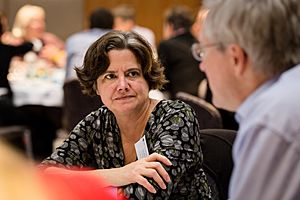Julie Ahringer facts for kids
Quick facts for kids
Julie Ahringer
FMedSci FRS
|
|
|---|---|

Ahringer in 2014
|
|
| Born |
Julie Ann Ahringer
|
| Nationality | American |
| Alma mater |
|
| Known for | RNA interference Caenorhabditis elegans |
| Spouse(s) | |
| Awards |
|
| Scientific career | |
| Fields |
|
| Institutions | Gurdon Institute University of Cambridge Laboratory of Molecular Biology University of Wisconsin–Madison |
| Thesis | Post-transcriptional regulation of fem-3, a sex-determining gene of Caenorhabditis elegans (1991) |
| Doctoral advisor | Judith Kimble |
| Other academic advisors | John Graham White |
Julie Ann Ahringer is an amazing American and British scientist. She is a Professor of Genetics and Genomics. This means she studies how our bodies are built and work, all the way down to our tiny genes.
Professor Ahringer is also the Director of the Gurdon Institute at the University of Cambridge. She leads a team of researchers. They study how genes are "turned on" or "turned off" in living things. This process is called gene expression.
Her lab did something really cool. They were the first to turn off most of the genes in a tiny worm called C. elegans. They did this using a method called RNA interference (RNAi). This helped them learn what each gene does. Her research helps us understand how living things develop and how our bodies are organized.
Contents
Becoming a Scientist: Julie Ahringer's Education
Julie Ahringer grew up in Miami, Florida. She went to Lafayette College in Easton, Pennsylvania. In 1984, she earned a degree in Chemistry.
Later, she went to the University of Wisconsin–Madison. There, she earned her PhD, which is a very high degree in science. She worked with a scientist named Judith Kimble during this time.
Discoveries and Career Highlights
After getting her PhD, Julie Ahringer moved to Cambridge, England. She did more research at the Medical Research Council (MRC) Laboratory of Molecular Biology (LMB). She worked with John Graham White.
In 1996, she became a group leader in the genetics department in Cambridge. Then, in 1998, she moved to the Gurdon Institute. This is where she made her big discovery.
Understanding Genes with C. elegans
Professor Ahringer's team created a special library of tools. These tools could turn off almost every gene in the C. elegans worm. This was the first time anyone had done this for an animal!
By turning genes off one by one, scientists could see what happened. This helped them understand what each gene's job was. Her lab uses these tiny worms to study how genes work. They also look at how chromatin (the stuff that makes up chromosomes) helps organize our genome. This research helps us understand how living things grow and develop. It also helps us learn about diseases.
Awards and Recognition
Julie Ahringer has received many important awards for her work.
- In 2003, she became a member of EMBO. This is an organization for top life scientists in Europe.
- In 2004, she gave the Francis Crick lecture for the Royal Society. This is a big honor!
- In 2007, she was chosen as a Fellow of the Academy of Medical Sciences (FMedSci).
- In 2020, she won the George W. Beadle Award. This award is given for amazing contributions to genetics.
- In 2021, she was elected a Fellow of the Royal Society. This is one of the highest honors for scientists in the UK.
She also helps guide other scientists. She is on the scientific advisory board for the Medical Research Council (MRC).
Family Life
Julie Ahringer married Richard Durbin in 1996. They have two children together.

